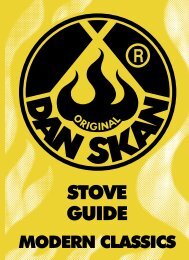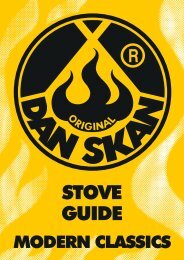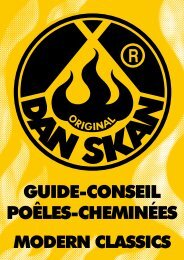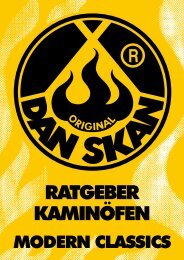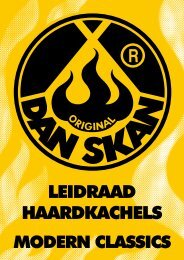STOVE GUIDE - DanSkan
STOVE GUIDE - DanSkan
STOVE GUIDE - DanSkan
You also want an ePaper? Increase the reach of your titles
YUMPU automatically turns print PDFs into web optimized ePapers that Google loves.
TOPFIRE… FIRE FROM ABOVE<br />
THE RIGHT START-UP AND HEATING FIRE<br />
INTELLIGENT SELF CONTROL<br />
DAN SKAN stoves have an extraordinary efficiency and very economical burning because of the ‘intelligent self-control’ of the DAN<br />
SKAN automatic.<br />
Stove dealers throughout Europe confirm that DAN SKAN stoves require clearly less fuel to provide a very good heat output<br />
compared to other stoves.<br />
A prerequisite for effective and economical combustion is, of course, that you burn your stove as we recommend with our Top Fire<br />
method as well as our other operating instructions.<br />
The most important thing is that the combustion is always undertaken with a fully closed riddle grate with an ash layer of approximately<br />
50 mm thick in the fire chamber bed and that only the secondary and tertiary air is used from above the fire.<br />
TOP FIRE AS THE STANDARD FIRE<br />
The riddle grate should be closed (pushed in) and the pull control open (pulled outwards).<br />
Before re-lighting the fire, push some of the ashes at the very front of the bed towards the middle and back so that they cover the<br />
riddle grate. Ensure that you still leave some ash covering the front but that the riddle grate is covered by a depth of approximately<br />
50mm to form a good air seal.<br />
Position four or five good sized logs, side to side on the bed with their sawn ends away from the glass. The largest of the logs<br />
should be set towards the front of the fire chamber.<br />
The usual kindling wood for lighting the fire is then placed on top of this wood pile – not under! The fire is then lit from above = TOP<br />
FIRE!<br />
It may be necessary to leave the stove door ajar slightly to maximise the combustion air for a quicker start. Do not leave the stove<br />
unattended when the door is ajar.<br />
The fire will then burn from the top downwards and build a good layer of embers for further combustion. The starting fire phase<br />
with the slightly open door will take approximately 30 minutes.<br />
When the fire is burning well and the fire chamber walls are soot-free the stove is operating at the appropriate temperature and the<br />
door can then be closed. The starting fire can then burn for another 1 or 2 hours depending on the original fuel load.<br />
When the fire has burned down and turned into a ‘flat fire’, but still with good flames, you can then reload with two hardwood logs,<br />
such as beech or oak placing these side to side, re-loading every 30 to 50 minutes or so. Be careful only to use dry wood as it will<br />
always burn with flames and not smoke. Only flames create real heating power and keep the up-draught in the flue system working.<br />
When you reload ensure that this is done when there are still some flames arising from the embers – leaving the reloading until<br />
there are no flames could be problematic and make it difficult to re-start the up-draught needed for efficient combustion.<br />
The self opening and closing DAN SKAN automatic system will sustain effective combustion throughout the fire cycle so that all of<br />
the flue gases are burned and none escape unused through the flue system to provide you with the highest possible efficiency.<br />
THE TOP FIRE PICTURES (see right hand page)<br />
TOP FIRE AS STANDARD FIRE<br />
Pictures 1 and 2: Ash in front of the fire chamber bed is pushed<br />
towards the back and over the riddle grate with a scraper, leaving<br />
some covering of ash at the front of the bed. The ash should form a<br />
bed of at least 50mm deep to create a good air seal over the riddle<br />
grate which should be closed<br />
Pictures 3 and 4: Three to five logs of easily combustible wood are<br />
laid side to side in the fire chamber with the largest logs to the front.<br />
The usual kindling wood for lighting the fire is then placed on top of<br />
this wood pile – not under!<br />
Picture 5: The fire is then lit from above = TOP FIRE!<br />
Picture 6A: The door of the stove should be opened slightly to get<br />
more starting air and to create a bellows effect. The pull control is<br />
opened for the whole of the combustion.<br />
Picture 7A: The fire burns from the top downwards and will build a<br />
good layer of embers for further combustion.<br />
Picture 8A: When the fire is burning well and the fire chamber walls<br />
are soot-free the stove door can then be closed. At this stage hardwood<br />
logs such as beech or oak can be loaded, again laid side to side.<br />
TOP FIRE AS AN AIRBOX-FIRE WITH EXTERNAL AIR<br />
Pictures 1 to 5: Information as previously for the starting fire.<br />
Pictures 6B to 8B: Combustion using 100% external air is always<br />
undertaken with the stove door closed and with the CLASSIC Line<br />
range the pull control is also closed.<br />
90



